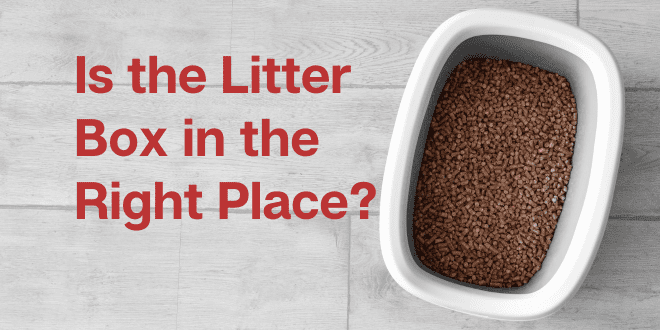
When a cat stops using the litter box it’s a very stressful situation. It’s obviously extremely stressful for the poor cat but it’s also very stressful for the human family members. Nobody is happy when kitty pees in locations other than the litter box.
There are many reasons for litter box avoidance and we have several articles here on our website that cover this topic. As always though, the very first thing you should do when your cat stops using the box is to take him to the veterinarian in order to rule out any underlying medical issue. This critical first step should never be skipped, even if you’re convinced the problem is behavioral.
One reason for elimination outside of the box that doesn’t always get the attention it deserves is location aversion. Where you place the box can play an important role in whether it gets successfully used, periodically used, or never used. Here are a few potential triggers for litter box location aversion.
A Litter Box That’s too Close to Food
Their survival instinct tells cats not to eliminate where they eat. The last thing a cat wants is to have the scent of waste attracting predators to where he eats, and sleeps. It’s important not to attract predators to the colony. It’s also important not to alert prey. The reason indoor cats cover their waste in the litter box is rooted in that same survival instinct. Covering the waste makes it less able to be detected by predators. If you place the litter box close to the feeding station, the cat will often choose to eliminate somewhere else.
A Litter Box That’s too Inconvenient for Your Cat
The litter box isn’t the human family member’s favorite part of household décor. As a result, many cat parents place the litter box in the most out-of-the-way locations in the home. It gets hidden in basements, wedged in the corner of the garage or shoved into closets. Putting the litter box in the household equivalent of Siberia will often backfire on you. When your cat’s bladder is full, he’ll truly appreciate having a litter box conveniently located. This becomes even more important as your cat ages or has mobility problems. If you live in a three-story home would you like to have to travel down several sets of stairs to get to the one bathroom in the home? Probably not. Provide litter boxes that are conveniently located – and that includes providing an adequate number of boxes based on the size of your home and the number of cats in your family. The general rule of thumb is that the litter boxes should outnumber your cats by at least one.
A Litter Box That’s too Private
When it comes to taking care of personal business, humans definitely prefer privacy. Cats, however, don’t need as much privacy. Granted, you don’t want to place the litter box right smack in the center of high-traffic areas of the house, but you also don’t want it so isolated that it becomes forgotten or difficult to access. Find the right balance between adequate privacy and convenience.
A Litter Box That’s too Uncomfortable
Does your cat have to squeeze through a pet door to get to the box? Does your cat have to wedge between the tub and the toilet to gain access to the small box you’ve tucked in there? With older cats, keep in mind that arthritis or limited mobility may make it too difficult to access a litter box location that was originally adequate during younger years. Make sure the box is in a location that provides comfort and ease of use. Litter box location should be about the cat’s convenience.
A Litter Box That’s in a Noisy Location
Just as you don’t want to locate a box in an extremely remote area of the house, you also don’t want to go to the other extreme and put the box in a high-traffic area. Your cat doesn’t want to be in the middle of personal duties in the box while the children are running around just inches away or the family dog is barking at him. As previously stated, provide a healthy balance.
A Litter Box That’s Not Safe
I think of all the location aversion issues I help clients with, this is the biggest one. If a cat doesn’t feel safe in the litter box, there is absolutely no reason to return there. If you have a multicat household and one cat ambushes another in the box, if the dog goes after kitty or there’s any other reason to feel anxious about safety in there, he will seek out other options. The litter box needs to be located in an area that provides safety and the set-up itself must encourage security (an uncovered box, for example). Don’t put boxes in closets or other locations that limit the cat’s escape potential. Ideally, I recommend locating the box on the opposite side of the room’s entrance. This gives the cat maximum visual warning time to see if anyone is approaching. For a cat, being in the litter box is a very vulnerable time and the ability to escape provides added security. If you notice there is tension between your cats in the home, it’s also time to do some behavior work to help them find peace with each other. An important part of that behavior work will involve making environmental changes, increasing resource locations, and helping them form more positive associations with each other. Remember, they didn’t pick this pairing, you did. In an outdoor environment, these particular cats may not have chosen a relationship so it’s up to you to help them be able to live together in peace. They not be best friends but each cat should feel safe and secure engaging in everyday activities.
In a multicat household, pay attention to preferred areas of each cat. This way, you can place boxes around the house where each cat spends the most time so one cat won’t have to cross another cat’s territory just to get to the box. Remember, litter boxes should out-number the cats by at least one.
Litter boxes placed in the garage, screened-in porch or even in the basement often don’t provide a sense of safety for the cat. Look at the potential dangers present when deciding on a litter box location. Is the box located near objects that could be toxic to your cat, such as paint cans, garden supplies, insecticides? Are there anti-freeze or other chemical spills on the garage floor? Does the litter box in the screened-in porch create fear due to the high risk of other animals coming around? Even if your cat can’t get out, coming face to face with an unfamiliar cat or maybe a skunk doesn’t inspire location security. A litter box in the laundry room is a popular location choice for many but if you have a fearful cat, how will he react if the washer suddenly goes into the spin cycle while he’s trying to eliminate?
It’s About Your Cat
The best location for your cat’s litter box may need to be customized based on his personality, your household dynamics and other factors specific to your situation. What works for your neighbor’s cat may not be right for your cat. What’s most important is that when it comes time to eliminate, your cat has a convenient, clean, comfortable and safe litter box always available. If you’re in doubt about whether the box is in the right location, get an extra box and place it in another spot and let your cat have the choice. Your cat will be the first to tell you whether you’ve gotten it correct or not.
Need More Information?
For more specifics on litter box aversion and litter box problems, refer to best-selling books by Pam Johnson-Bennett. The books are available in bookstores and online. We’ve included links to Amazon here on our website.
Note: If you have a question about your cat’s behavior or health, contact your veterinarian. This article is not intended as a medical diagnosis nor is it a replacement for your cat’s regular veterinary care. This article is for general information purposes only.


